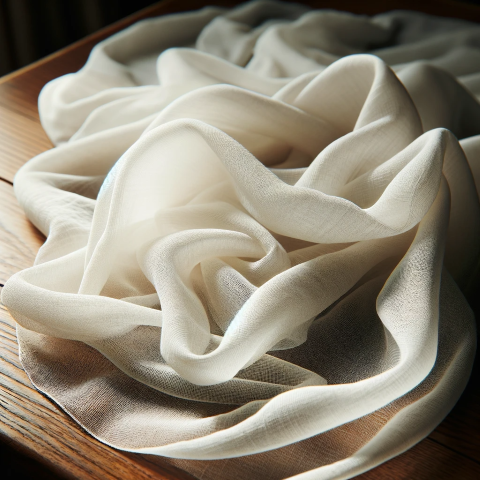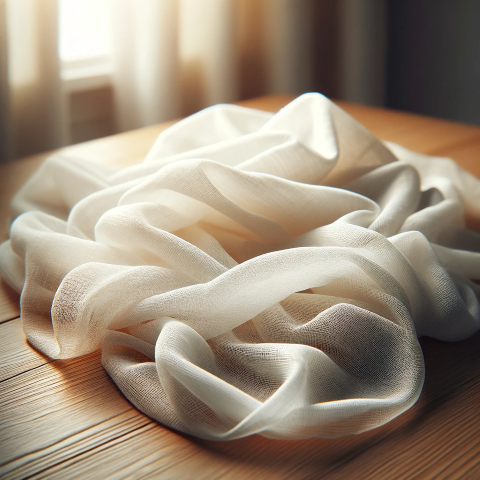Last Updated on: 10-Jan-2024 (6 months, 17 days ago)
Share on Facebook • Share on Twitter
Mousseline Magic: Unveiling the Fabric That Whispered Through History
The Ethereal Weave: Mousseline in the Tapestry of Textiles
Mousseline, also known as muslin in the English-speaking world, is a testament to the finesse and sophistication attainable in textile production. Its story begins in the ancient city of Mosul in present-day Iraq, where it was first woven, hence the name 'mousseline'. With its roots in the Middle East, the fabric found its way along the Silk Road, captivating the courts of Europe with its delicate touch and sheer appearance.
A Fabric's Journey from Ancient to Modern Times
Originally made from pure silk, mousseline gained popularity in France during the 17th and 18th centuries, becoming synonymous with the airy elegance of the French nobility's summer attire. As the fabric traversed geographies, its composition evolved, incorporating cotton to make it more accessible, yet no less beloved by the fashion-forward of the day.
- Silk Mousseline: Luxurious and lightweight, often used in formal wear.
- Cotton Mousseline: More accessible and perfect for everyday clothing.
- Mousseline de Laine: A woolen variety, offering a sturdier drape.
- Double Mousseline: Two layers of mousseline joined together for increased opacity.
- Crinkled Mousseline: Treated to have a permanently wrinkled texture.
- Use a gentle hand wash or dry clean to maintain the fabric's integrity.
- Iron on a low setting with a pressing cloth to prevent heat damage.
- Avoid wringing or twisting the fabric to preserve its shape and finish.
Renowned Creators and Purveyors of Mousseline
- Herms: This luxury French house has long been synonymous with the finest silk mousseline, particularly recognized for its iconic scarves that exhibit intricate prints and vibrant colors.
- Fabindia: With its roots in India, a country with a historic connection to muslin, Fabindia upholds traditional techniques while catering to contemporary tastes, offering a range of cotton mousseline apparel and home textiles.
- Dior: The French fashion label Dior has frequently incorporated mousseline in its haute couture collections, showcasing the fabric's fluidity and elegance on the runway.
- Canclini: An Italian textile manufacturer renowned for its high-quality cotton mousseline, Canclini combines innovative techniques with heritage craftsmanship to produce luxurious shirting fabrics.
- John Kaldor Fabricmaker: This UK-based company offers a diverse range of mousseline fabrics, including those that are crinkled and patterned, suitable for fashion designers and home sewers alike.
Versatile Applications of Mousseline
- Fashion Apparel: Mousseline is a staple in creating flowing dresses, scarves, and blouses, valued for its breathability and delicate texture.
- Home Dcor: Lightweight mousseline curtains offer a translucent window treatment that diffuses light beautifully in interior spaces.
- Wedding Gowns: Bridal designers often choose mousseline for its ethereal quality, making it ideal for veils and overlays on wedding dresses.
- Theatrical Costumes: Its lightness and flow make mousseline a favorite for stage costumes, adding movement and a hint of opulence.
- Medical Uses: In its simpler, unbleached form, mousseline is used for medical gauze and bandages due to its softness and absorbency.
Conclusion: The Timeless Allure of Mousseline
The narrative of mousseline is interwoven with the history of fashion itself, a fabric that has graced countless generations with its airy charm and versatility. From the opulent silks that once adorned aristocracy to the breathable cottons that now dress the modern consumer, mousseline remains a fabric of choice for those who seek a blend of elegance and comfort. Its story is not confined to the past but continues to be written by the hands of designers, manufacturers, and wearers who are drawn to its ethereal quality.
Today, as the textile industry confronts the imperative of sustainability, mousseline offers a blueprint for the futurewhere luxury does not compromise on responsibility. Innovations in fabric production have made it possible to produce mousseline that not only meets high aesthetic standards but also adheres to ethical manufacturing practices. As we look forward, mousseline will undoubtedly adapt to the demands of eco-conscious fashion, preserving its legacy while embracing innovation.
In this fabric, we find a reflection of our desire for transcendent beauty that does not weigh heavily upon our shouldersliteral and metaphorical. Mousseline, with its whisper-like touch and gossamer appearance, will continue to be treasured in the annals of textile artistry. It is a fabric that does not just drape; it dances to the rhythms of history and innovation, ensuring its place in the wardrobe of tomorrow.
�General term for crisp, lightweight, semi-opaque fabrics. May be made from a variety of fibers.
A general term for very fine, semi-opaque fabrics-finer than muslins-made of silk, wool or cotton.
Some more terms:
Cord Chronicles: Unveiling the Secrets of Textile Evolution
The Fabric of History: Unraveling the Mystique of Cord Welcome, textile enthusiasts, to a journey through the captivating world of cord. Cord, with its intricate weave and rich history, is more than...
Read about CordAbercrombie: Unraveling Its Textile Legacy and Global Influence
Scottish tartan fabric woven with a blue and black ground and green and white over-check. Medium weight, usually not heavy enough for outerwear. Originally all-wool, but now may contain a proportion...
Read about AbercrombieTricoline
Tricoline, also known as tricotine or tricot, is a type of lightweight fabric that is commonly used in the production of clothing and home furnishings. It is made from 100% cotton or a blend of...
Read about TricolineExploring Distressed Textiles: Techniques and Trends in Vintage Fashion
Artificial aging by wear and tear to leather or wood. In wood this can be physical distressing such as dents, gouges, worm holes, and scratches, or finish distressing such as wearing away, crackle,...
Read about DistressedHakama
Hakama are a type of traditional Japanese clothing. Hakama cover the lower body and resemble a wide, pleated skirt. Hakama were originally worn only by men, but today they are worn (albeit slightly...
Read about HakamaGrospoint
Grospoint is a luxurious and ornate fabric widely used in the textile industry. It is characterized by a raised pattern or design created by weaving thicker, heavier yarns into the fabric. The term...
Read about GrospointSatin
Satin is a type of fabric renowned for its smooth, glossy, and lustrous surface. It is widely used in the textile industry to create luxurious garments, elegant home decor items, and various...
Read about SatinCretonne
Cretonne is a versatile fabric widely used in the textile industry for various applications, including upholstery, drapery, and home furnishings. It is characterized by its sturdy and durable...
Read about CretonneOn this page
Add a definition
- The term you want to define
- Its definition in 500 words or less
- Attach an image if necessary.
- Optionally, tell us about yourself in 200 words or less!
Companies for Mousseline:
- Company name
- Company address
- Attach a logo, if necessary.
- Optionally, tell us about yourself in 200 words or less!

 The US textile industry has a long history of technological innovation.
The US textile industry has a long history of technological innovation.

